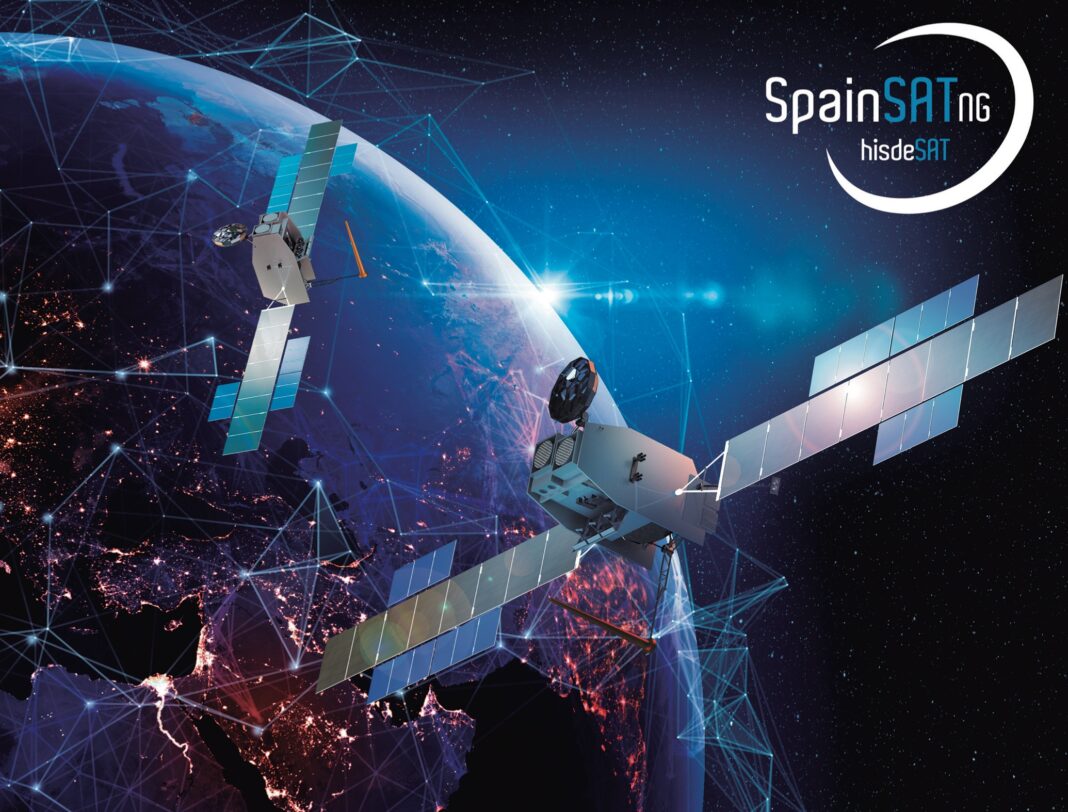Spainsat NG is the next generation of secure communications satellites for the Armed Forces and the State being built by Spain.
Under the name Spainsat New Generation (Spainsat NG), the next generation of powerful and more efficient Spanish satellites, designed to provide greater secure communications capabilities to the Spanish Armed Forces and State authorities, are already under construction and will be launched into space in 2024 and 2025.
The set is composed of two new generation satellites and their ground control and monitoring component, which will allow linking via satellite with military units deployed in areas of operations outside Spanish territory. The Spainsat NG program is managed in coordination between the Spanish Ministry of Defense and the government satellite services operator Hisdesat.
The satellites
The two large and sophisticated twin satellites – Spainsat NG I and Spainsat NG II – each weighing approximately 6.1 tons, under development since May 2019 by the Airbus Defence and Space and Thales Alenia Space consortia, are based on Airbus Defence and Space Corporation’s Eurostar Neo platform.
Their central structure is about the size of a large van – some seven meters long – and their total wingspan with solar panels deployed is close to 50 meters. The array was equipped with an efficient electric propulsion system, which should position and maintain them in their respective geostationary orbits some 36,000 kilometers above the Earth.
Once in orbit, Spainsat NG I will occupy the 30º West orbital position and NG II will be located at 29º East, covering a wide area of the planet from the United States to South America, the Middle East, Africa and Europe and reaching as far as Singapore, allowing secure communication over two thirds of the Earth.

The new satellites will provide expanded and more secure command and control capabilities to the Ministry of Defense and the Spanish State, connecting neuralgic centers linked to security, defense and intelligence.
Three-way communication
Spainsat NG has three operating bands of the electromagnetic spectrum reserved for government use.
The main one is the X-band, a spectrum reserved for military use. Another is the military Ka band, which is used for the transmission of large volumes of data. The new addition to the communications satellite currently in use is the UHF band, which is of special interest to the Armed Forces.
A novelty in the X-band is that it will have a reconfigurable active antenna, both for reception and transmission. It offers dual polarization and «can generate 16 different communications beams,» notes the program manager, which means that they are all independent of each other and each can have a different size, shape and orientation.
In addition, they have «geo-location capability and can distribute their power in a flexible way», a great evolution compared to the current Spainsat, which has only one active antenna for reception – called IRMA – with a single polarization and four beams with geolocation capability.

In the military Ka-band, the Spainsat NGs will use six steerable beams and a semi-global receive beam, which surpasses the capabilities currently offered by the Spainsat, which only has one steerable transmit beam and one fixed receive beam.
This remarkable increase in capabilities is largely due to the fact that the NGs integrate a DTP -acronym for Digital Transparent Processor-. The DTP makes the satellites capable of managing a total bandwidth of eight Giga Hertz, allowing complete connectivity and control over the available channels in the X and Ka bands and frequency reuse. On the other hand, Spainsat’s mechanics are based on the assignment of classic analog transponders.
A reserve margin has been added to the required capacities, which can be made available to other official national or third allied and friendly countries, so the new spacecraft were designed in accordance with the security requirements of NATO.
Broad industrial participation
According to the Spanish Ministry of Defense, Spain’s space industry is making a major contribution to making the complete system a reality. The companies Acorde, Anteral, Arquímea, Airbus Crisa, GMV, Iberespacio, Indra, Sener Aeroespacial, Tecnobit and also the Instituto Nacional de Técnica Aeroespacial (INTA) are making key contributions in the field of state-of-the-art electronics and mandatory testing.
The integration of the communications module is carried out in Spain, with Airbus Space Systems in Spain as the company responsible for the X-band payload and Thales Alenia Space Spain for the UHF and military Ka-band payloads. Other Spanish space companies will also be involved.
Terrestrial component
As or more important than the satellites themselves, the ground component of the Spainsat NG system is used to transmit commands (telecommands) of all kinds to ensure the proper functioning, resolve incidents and carry out movements of the space component.

The main control and monitoring center will be set up in Hoyo de Manzanares, near Madrid, and the redundant one will be located in INTA’s Maspalomas Space Station, on the southern tip of the island of Gran Canaria. Its development, construction and main technical equipment will be the responsibility of the Spanish company GMV.
Putting into orbit
Hisdesat contracted the services of the North American company SpaceX for its Falcon 9 launcher to put NG I into orbit in 2024 and NG II in 2025. The signing took place in Madrid on November 4. The agreement established with SpaceX ensures that the launch can be carried out from either of the two launch complexes that the American company has at Cape Canaveral (Florida), one in the military zone and the other in the area dedicated to commercial or scientific flights.
With two propulsion stages, the Falcon 9 is a recoverable rocket, considered the most reliable on the market. From its first flight on June 4, 2010, until March 24, 2010, it has flown 218 times, 216 of which have been fully successful, for a reliability rate of 99%. The high success rate of its flights is evidenced by what happened in 2022, when the Falcon 9 was launched 60 times – an average of five times a month – all of which were successful.






